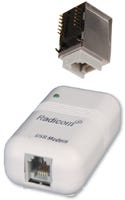Small Modem Saves Space in Home Monitoring Devices
Wireless data collected directly from patients during normal physical activities could enable the development of better knee implants
July 3, 2008
Originally Published MPMN July 2008
BREAKTHROUGHS
Small Modem Saves Space in Home Monitoring Devices
|
The TinyModem is the world's smallest dial-up modem, according to its manufacturer. |
As an increasing number of patient-monitoring applications move from the hospital to the home, OEMs are seeking ways to make their products less obtrusive domestic presences. One way to achieve a smaller footprint is to use smaller components to reduce the overall size of the device. In an effort to enable OEMs to do just that, Radicom Research Inc. has developed what it claims is the world’s smallest dial-up modem.
Measuring 0.66 × 1.25 × 0.75 in., the TinyModem includes a built-in RJ-11 phone jack without sacrificing any of the standard features of similar, larger modules. The modem is designed to be embedded in a base station, which collects information received from a connected monitoring apparatus, such as a paddle on a heart monitor or a blood-oxygenation unit. Information is then communicated from the modem to a remote location. “More than anything, [the component] offers designers flexibility,” says Floyd Kling, OEM sales manager. “They can either design smaller monitoring systems than they could before, or they can use the extra real estate to add new features.”
Since most monitoring systems still rely on connecting wires, base stations that are easily transportable provide convenience to patients, according to Kling. “The patient may have difficulty ambulating and wants to be able to set the system up in one place for a period of time, and then another,” Kling says. “This modem enables designers to make products that can be used anywhere in the home.”
The modem features a –40° to 85°C temperature range and tolerates isolation voltages up to 3750 V. EMC and EMI shielding and a built-in data pump are included, and dial-up data rates range from 300 to 56 Kbps.
Though dial-up connection is widely regarded as inferior to broadband on today’s consumer markets, the slower technology can offer benefits in the patient-monitoring sector. “Most of the patients using home monitoring systems today did not grow up during the Internet Age, and many aren’t particularly tech savvy,” Kling explains. “This technology doesn’t require that they know anything about broadband since they can integrate it with a basic phone jack.”
Recognizing, however, that the patients of tomorrow will be comfortable with broadband and wireless technologies, Radicom plans to offer components that incorporate these technologies in the near future. “Bluetooth compatibility could provide significant advantages,” Kling says. “With [Bluetooth], the patient would never have to move the base station—the monitoring apparatus could communicate with it wirelessly from any place in the house.”
Radicom Research Inc., San jose
www.radi.com
Copyright ©2008 Medical Product Manufacturing News
You May Also Like


.png?width=300&auto=webp&quality=80&disable=upscale)
